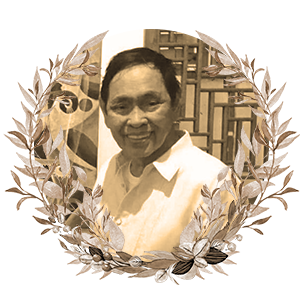
Visual Artist
June 6, 1931 – July 13, 2021
Chances are, you’ve held the work of an accomplished artist in your hand without knowing it. If you recall the orange P20 bill featuring President Manuel Quezon first issued on March 3, 1986, and the violet P100 bill featuring President Manuel Roxas first issued on April 18, 1987, those were the works of a particular artist who made such depictions part of his life’s work.
Angel Cruz Cacnio was a painter whose images and scenes became part of the country’s veritable cultural images—those etchings on our currency, the bold energy of the cockpit, the work of farmers and fishermen, the riot of colors of our wide heritage of folk dances.
He was born in Malabon, the youngest of the eight children of Flaviano Cacnio, a fisherman, and Telespora Cruz. He grew up amid folk designs decorating old horse-drawn rigs and fishing banca. He also grew up enjoying komiks, especially those drawn by Francisco Coching, later a National Artist for Visual Arts.
Cacnio attended the School of Fine Arts of the University of the Philippines (UP), where his classmates included Salvador Cabrera and future National Artist Federico Aguilar Alcuaz.
He graduated from UP in 1954, but not before making a mark as one of the first winners of the Shell National Student’s Art Competition. His work, “Tatlong Sabungero,” won first prize in the third edition of the contest in 1953, and made sabong a favorite theme in Philippine art.
He married Amelia Reyes Cacnio in 1959, with whom he had four children—Mabini, Michelle Pilar, Michael, and Ferdinand. Both Michael and Ferdinand have since made names for themselves as sculptors.
Cacnio worked for the Ramon Roces Publications and started joining national art tilts. In 1964, he won the Apolinario Mabini Centennial Art Competition with his work, “The Capture of Mabini.”
He also won prizes in the coin design contest of the Central Bank of the Philippines, and his designs were used for the one-centavo coin featuring Lapu-Lapu and the five-centavo coin featuring Tandang Sora, both first minted on 1967.
His designs for the 25-centavo coin featuring Juan Luna and the swallowtail butterfly and the 50-centavo coin featuring Marcelo H. del Pilar and the Philippine eagle were first minted in 1983.
He received the Gintong Parangal ng Malabon Award for Art in 1981 and the Centennial Gintong Ama Award for Arts and Culture in 1996, among other awards and recognition.
Cacnio co-founded the Visual Artist Creative Group and the Tuesday Group of Artists, and was an active member and advocate for the Sining Tambobong Foundation and Malabon Tourism. His house in Barangay Hulong Duhat in Malabon serves as an art gallery featuring his masterpieces and the works of Malabon’s artists. He held over 50 solo and group exhibits around the world, and had also been featured in various international publications.
He died from complications of pneumonia at the age of 90.
In 2016, the National Commission for Culture and the Arts (NCCA) exhibited a retrospective of his six-decade-long career in its gallery in Intramuros. The exhibit, “Angel of Art,” surveyed key representative works of Cacnio since the 1950s.
Delan Robillos, NCCA’s National Committee on Art Galleries vice chair and who curated the exhibit noted: “Patrons and newbie followers of Philippine art are beguiled by his meticulous choice of colors, hues, and tones, revealing complexity, intricacy and intensity all at once. His obras are brimming with Filipino values, culture, heritage, tradition, life, resilience, hope.”
0 Comments